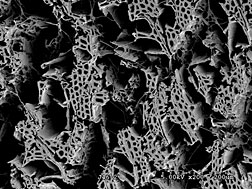- Number 370 |
- August 27, 2012
Emergent fungi implicated in ending the Carbon Era

Photo: Scanning electron micrograph of
wood being decayed by the white rot fungus
Punctularia strigoso-zonata
(Robert Blanchette, University of Minnesota).
The Carboniferous period was a good time for biomass: there was no natural microbe that would completely break down the dead plant matter. Because carbon remained trapped, levels of oxygen soared—allowing bugs to breathe easier and grow multiple feet long. The compiling biomass became coal, and most of the world’s supply was generated during that period 300-360 million years ago. But the era may have come to an end from an unlikely source: fungus. An international team of scientists, including researchers at the U.S. Department of Energy Joint Genome Institute (DOE JGI), has proposed that a new species of fungus broke down dead plant matter, the source for coal.
The evidence, presented online in the June 29 edition of the journal Science, suggests that the evolution of fungi capable of breaking down the polymer lignin, put an end to an era. The great bulk of plant biomass decayed and was released into the atmosphere as carbon dioxide, instead of accumulating as peat, which eventually was transformed into coal. The comprehensive study compared the complete genomes of dozens of fungal species, most of which were sequenced at the DOE JGI.
More… (link)[David Gilbert, 925.296.5643,
degilbert@lbl.gov]
